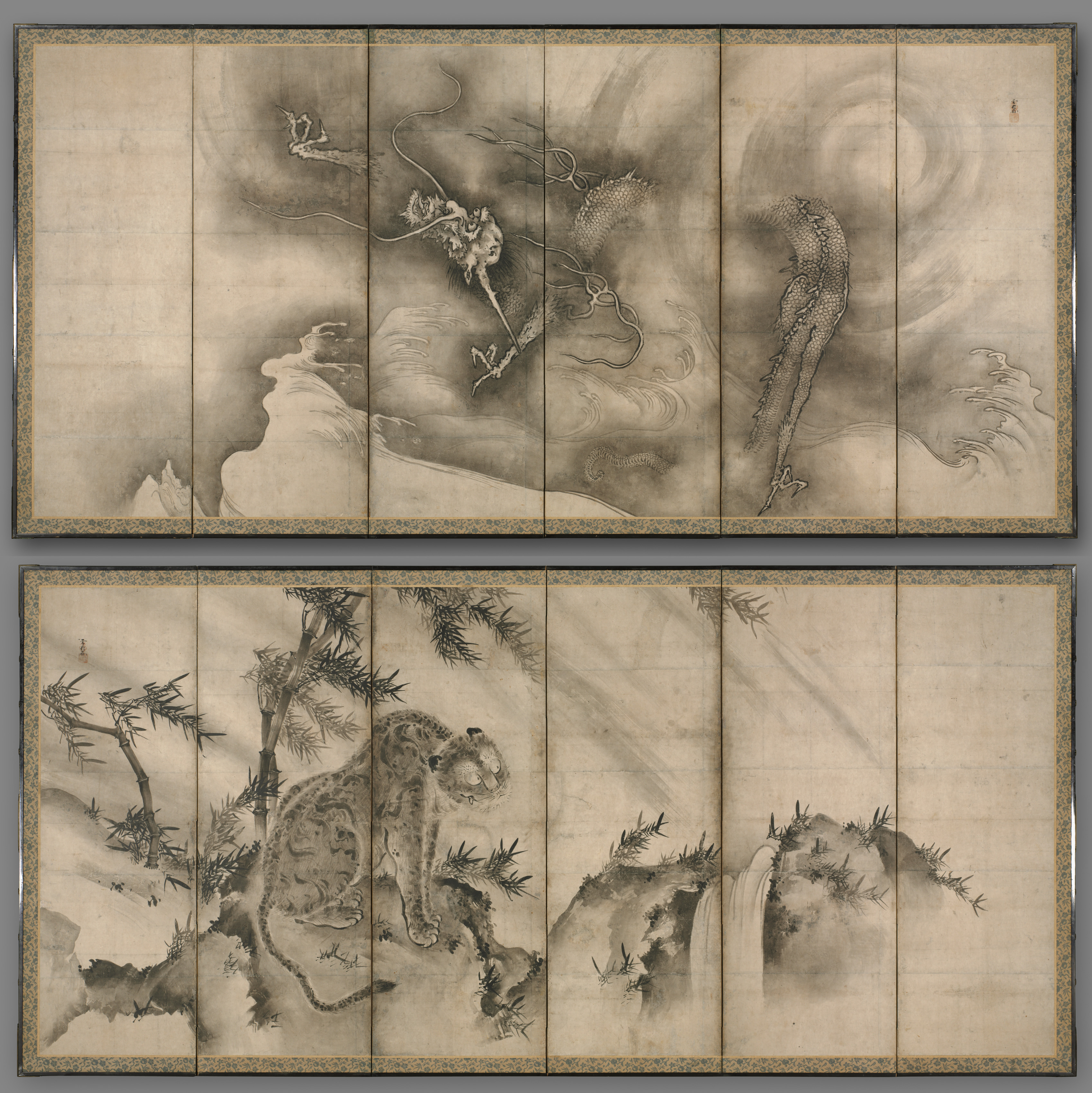The Cleveland Museum of Art
Collection Online as of April 19, 2024

Dragon and Tiger
c. 1546–56
(Japanese, c. 1492–c. 1577)
Each: 157.3 x 339 cm (61 15/16 x 133 7/16 in.); Framed: 172.3 x 354 cm (67 13/16 x 139 3/8 in.)
Purchase from the J. H. Wade Fund 1959.136
Location: not on view
Did You Know?
This pair of screens is considered the masterpiece of Sesson's body of work, and may have been created for the lord of Odawara in eastern Japan.Description
A tiger sits in a bamboo grove whipped with fierce wind, while a dragon claws through clouds above rough waves. Tiger and dragon are Chinese cosmological symbols of the balancing forces in the world, yin (the feminine aspect) and yang (the masculine aspect). The tiger's roar is also said to generate wind, and the dragon clouds. The screens may have originally been meant to express the fluctuating nature of the world as envisioned in the practice of military divination, or forecasting, based on the Yijing (Book of Changes).- H. Mitsui; C. Satomi.?-1959(Howard Hollis and Co., Cleveland, OH, sold to the Cleveland Museum of Art)1959-The Cleveland Museum of Art, Cleveland, OH, 1959-present
- Kakuzō Okakura 岡倉覺三 and Mataichi Fukuchi 福地復一 . Kōhon Nihon Teikoku bijutsu ryakushi 稿本日本帝國美術略史. Tōkyō: Nihon Bijutsusha, 1908. Mentioned: [p. 160]; Reproduced: p. 161Lee, Sherman E. Japanese Decorative Style. [Cleveland]: Cleveland Museum of Art, 1961. Mentioned and reproduced: pp. 50–51; cat. no. 47 archive.orgThe Cleveland Museum of Art. Handbook of the Cleveland Museum of Art/1966. Cleveland, OH: The Cleveland Museum of Art, 1966. Reproduced: p. 279 archive.orgThe Cleveland Museum of Art. Handbook of the Cleveland Museum of Art/1969. Cleveland, OH: The Cleveland Museum of Art, 1969. Reproduced: p. 279 archive.orgShimizu, Yoshiaki, and Carolyn Wheelwright. Japanese Ink Paintings from American Collections: The Muromachi Period: an Exhibition in Honor of Shūjirō Shimada. Princeton, NJ: Art Museum, Princeton University: Distributed by Princeton University Press, 1976. Mentioned and Reproduced: cat. no. 27, pp. 206–211The Cleveland Museum of Art. Handbook of the Cleveland Museum of Art/1978. Cleveland, OH: The Cleveland Museum of Art, 1978. Reproduced: p. 377 archive.orgCunningham, Michael R. "The Japanese Painter Yamaguchi Sekkei." The Bulletin of the Cleveland Museum of Art 67, no. 1 (1980): 2–16. Mentioned: p. 15, 7 www.jstor.orgLee, Sherman E., Michael R. Cunningham, and Ursula Korneitchouk. One Thousand Years of Japanese Art (650-1650): From the Cleveland Museum of Art: Catalogue. New York: Japan Society, 1981. Mentioned and Reproduced: pp. 68–69, no. 36Wilson, J. Keith. "Powerful Form and Potent Symbol: The Dragon in Asia." The Bulletin of the Cleveland Museum of Art 77, no. 8 (1990): 286–323. Reproduced: p. 304 www.jstor.orgTōyō kaiga no seika: tokubetsuten: Kurīvurando Bijutsukan no korekushon kara [東洋絵画の精華 : 特别展 : クリーヴラント美術館のコレクションから = Highlights of Asian painting from the Cleveland Museum of Art]. Nara, Japan: Nara National Museum, 1998. Reproduced: p. 114–115, cat. no. 76Cunningham, Michael R. Unfolding Beauty: Japanese Screens from the Cleveland Museum of Art. Cleveland, OH: Cleveland Museum of Art, 2001. Reproduced: pp. 14–15Admired from afar: masterworks of Japanese painting from the Cleveland Museum of Art [クリーブランド美術館展 : 名画でたどる日本の美 Kurīburando Bijutsukan ten: meiga de tadoru Nihon no bi ]. Tokyo: Tōkyō Kokuritsu Hakubutsukan, 2014. Reproduced: cat. no. 28, pp. 84–87Feltens, Frank, Yukio Lippit, and Aaron M. Rio. Sesson Shūkei: A Zen Monk-Painter in Medieval Japan. Washington, DC: Freer Gallery of Art, Smithsonian, 2021. Mentioned and Reproduced: pp. 43–47, fig. 13; pp. 184–185, no. 10
- Admired from Afar: Masterworks of Japanese Painting from the Cleveland Museum of Art. Tokyo National Museum, Tokyo, Japan (January 15-February 23, 2014); Kyushu National Museum, Fukuoka, Japan (July 8-August 31, 2014).Streams and Mountains Without End: Asian Art and the Legacy of Sherman E. Lee at the Cleveland Museum of Art. The Cleveland Museum of Art, Cleveland, OH (organizer) (June 27-August 23, 2009).Highlights of Asian Paintings from The Cleveland Museum of Art. Nara National Museum (organizer) (February 21-March 29, 1998); Suntory Museum of Art (April 28-June 21, 1998).Asian Autumn: Masterpieces from the Collection. The Cleveland Museum of Art, Cleveland, OH (organizer) (September 17, 1991-January 5, 1992).Japanese Ink Painting. Tokyo National Museum, Tokyo, Japan (organizer) (October 13-November 23, 1987).Byobu: The Art of the Japanese Screen. The Cleveland Museum of Art (organizer) (August 1-October 14, 1984).Japanese Screens from the Museum and Cleveland Collections. The Cleveland Museum of Art, Cleveland, OH (organizer) (March 23-May 8, 1977).Japanese Ink Paintings from American Collections: The Muromachi period: An exhibition in honor of Shūjirō Shimada. The Art Museum, Princeton University, Princeton, NJ (April 25–June 13, 1976).Juxtapositions. The Cleveland Museum of Art, Cleveland, OH (September 11-October 10, 1965).Japanese Decorative Style. The Cleveland Museum of Art (August 30-October 15, 1961); The Art Institute of Chicago, Chicago, IL (November 9-December 17, 1961).
- {{cite web|title=Dragon and Tiger|url=false|author=Sesson Shūkei|year=c. 1546–56|access-date=19 April 2024|publisher=Cleveland Museum of Art}}
Source URL:
https://www.clevelandart.org/art/1959.136